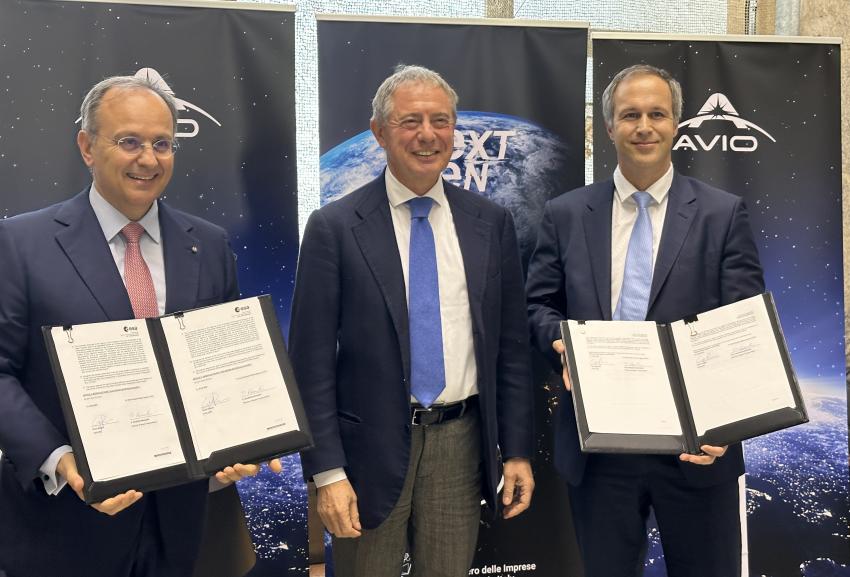Media and Stories |
Press release
PNRR: 285 euro million for innovative propulsion technologies and new generation launchers prototypes

Rome 13 March 2023 - Today, two contracts were signed at the headquarters of the Ministry of Enterprises and Made in Italy in the presence of Minister Adolfo Urso, the Director of Space Transportation Systems of the ESA, Daniel Neuenschwander, and the CEO of Avio, Giulio Ranzo. The total value of the contracts is over €285 million and is part of the initiatives for the Italian space industry to implement "NextGenerationEU" with the aim of enhancing the technological capabilities of the Italian industry for space access.
For the execution of these contracts, the Italian government has delegated the role of Technical Assistance to the European Space Agency (ESA), which will act as the Contracting Authority. The goal is to leverage the skills developed in Italy since the early 2000s through the Vega, Vega C, and Vega E programs for the development of new-generation propulsion technologies and launch system architectures.
"Today's signature is important for achieving the PNRR goals for the space sector. Once again, our commitment to a crucial sector is reaffirmed, in which Italy can and must have a leadership role thanks to the work done by Italian companies, whose technology receives unanimous recognition," declares Minister Adolfo Urso during the signing ceremony. "Today's signature is the first milestone of a path that will certainly be positive - Urso continues - I can only wish the best success to the initiatives and projects that will arise from these two contracts, which will enhance the entire sector's supply chain".
After the start of activities, with the contracts for the preliminary phases signed in June 2022, a more operational phase of two key development programs for Avio and, more generally, for the growth of Italian skills in propulsion and launch system architecture technologies will begin.
The first program, called STS and financed with €181.6 million until its completion, will be dedicated to the development, by 2026, of a flight demonstrator of new technologies and specific projects for a two-stage lightweight launcher with liquid oxygen and methane propulsion, with reduced environmental impact. The main developments are expected in the field of composite material cryogenic tanks, non-pyrotechnic separation systems, and integrated avionics systems based on aeronautical hardware and software extraction.
The second program, called HTE and financed with €103.7 million until completion, will be dedicated to the development of a new liquid oxygen and methane engine with high-performance technology, reduced environmental impact, and high thrust, with its detailed design and the realization of increasingly complex demonstrators up to the ground qualification test by 2026.
Daniel Neuenschwander, ESA Director of Space Transportation, has said: "Today we sign two contracts that prepare the future in a structured and far-sighted way. I would like to thank the Italian Government for its trust in the European Space Agency and for having decided to carry out the development and flight demonstration of new strategic technologies for the launcher sector in the European context. The launcher sector and independent access to space are essential for the European industry, and the Italian initiative, within ESA, is going in the right direction to increase European competitiveness, cooperation, and independence."
"The goal of the two projects," commented Giulio Ranzo, CEO of Avio, "is to prepare the ground for future-generation space transportation systems based on liquid propulsion with reduced environmental impact (potentially reusable). For this purpose, Avio can leverage the knowledge already developed on the smaller methane engine, capitalizing on this experience for more ambitious applications. The projects will be led by Avio as the main contractor, supported by an Italian industrial supply chain, as well as Italian research centers and universities. Avio also intends to involve innovative start-ups and small/medium-sized enterprises to accelerate the product development cycle, also introducing the latest and innovative methodologies of digital system engineering."
Liquid oxygen and methane technologies, thanks to their cleaner combustion characteristics, are indicated for potential reuse and today allow extensive use of single-material/single-component 3D printing technologies.